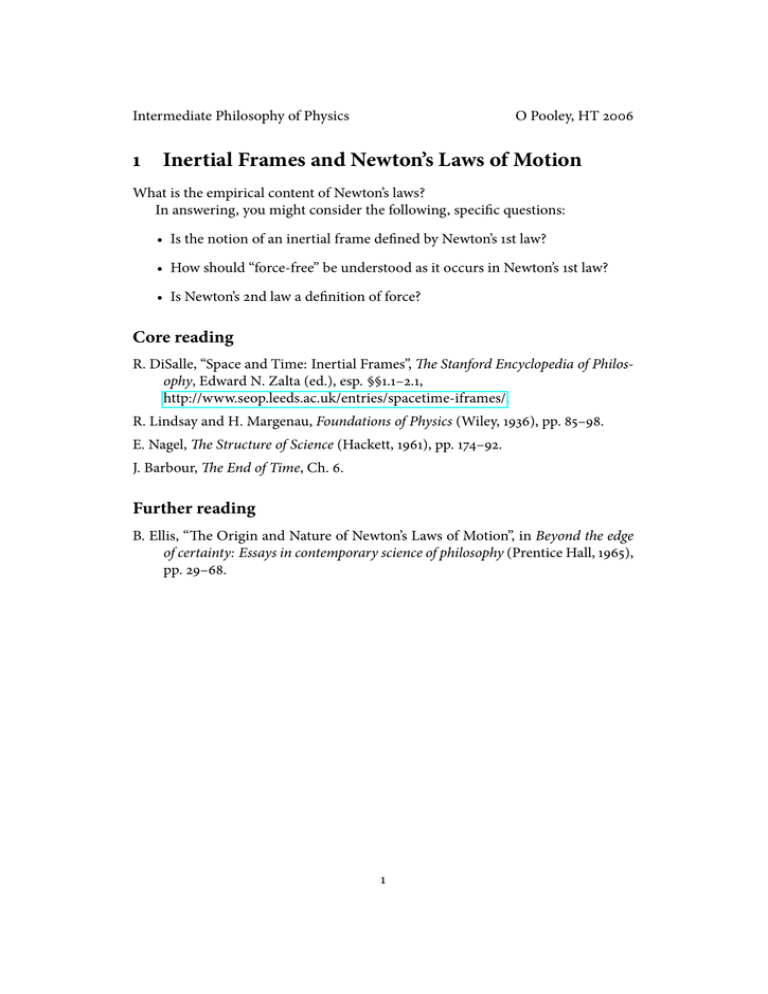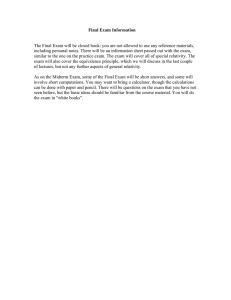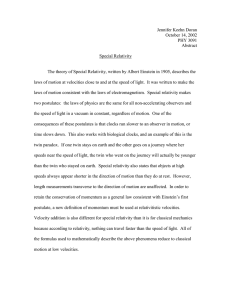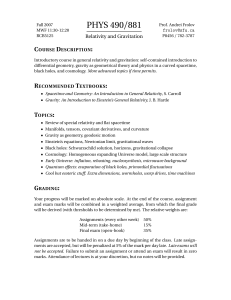Inertial Frames and Newton`s Laws of Motion
advertisement

Intermediate Philosophy of Physics 1 O Pooley, HT 2006 Inertial Frames and Newton’s Laws of Motion What is the empirical content of Newton’s laws? In answering, you might consider the following, specific questions: • Is the notion of an inertial frame defined by Newton’s 1st law? • How should “force-free” be understood as it occurs in Newton’s 1st law? • Is Newton’s 2nd law a definition of force? Core reading R. DiSalle, “Space and Time: Inertial Frames”, The Stanford Encyclopedia of Philosophy, Edward N. Zalta (ed.), esp. §§1.1–2.1, http://www.seop.leeds.ac.uk/entries/spacetime-iframes/. R. Lindsay and H. Margenau, Foundations of Physics (Wiley, 1936), pp. 85–98. E. Nagel, The Structure of Science (Hackett, 1961), pp. 174–92. J. Barbour, The End of Time, Ch. 6. Further reading B. Ellis, “The Origin and Nature of Newton’s Laws of Motion”, in Beyond the edge of certainty: Essays in contemporary science of philosophy (Prentice Hall, 1965), pp. 29–68. 1 Intermediate Philosophy of Physics 2 O Pooley, HT 2006 The Principle of Relativity State the principle of relativity as clearly as you can and examine its role in Einstein’s 1905 derivation of the Lorentz transformations. In particular, can you explain how such a dynamical principle has implications for kinematics? Core reading A. Einstein, “On the electrodynamics of moving bodies”, Part 1, §§1–4, in Lorentz, Einstein, et al., The Principle of Relativity (Dover, 1952). An alternative translation can be found in A. I. Miller, Albert Einstein’s special theory of relativity (Addison–Wesley, 1981). It is also available online: http://www.fourmilab.ch/etexts/einstein/specrel/www/. R. Torretti, The Philosophy of Physics (CUP, 1999), pp. 249–60. H. R. Brown, Physical Relativity (OUP, 2005), Chs 3 and 5, §§1–4. Further reading R. Torretti, Relativity and Geometry (Pergamon, 1983; Dover, 1996), Ch. 3, esp. §§1– 4. M. Freidman, Foundations of Space-Time Theories (Princeton University Press, 1983), Ch. 4, §5 (§§1 and 2 maybe necessary background). H. R. Brown and R. Sypel, “On the meaning of the relativity principle and other symmetries”, International Studies in the Philosophy of Science 9 (1995): 235– 53, esp. §§2 & 3. (An offprint is available in the philosophy library.) H. R. Brown and O. Pooley, “The origin of the spacetime metric: Bell’s ‘Lorentzian pedagogy’ and its significance in general relativity”, §3, in Callender and Huggett (eds), Physics Meets Philosophy at the Planck Scale (CUP, 2001), pp. 256–72, §3. E-print: gr-qc/9908048. 2 Intermediate Philosophy of Physics 3 O Pooley, HT 2006 The Twin Paradox Why might clock retardation, the effect at the heart of the twin paradox, appear paradoxical? Can it be explained within the confines of special relativity? If so, how? If not, why not? Core reading W. Rindler, Essential Relativity, §2.14 (pp. 45–7). W. Rindler, Introduction to Special Relativity, §12 (pp. 30–1). R. Angel, Relativity: The Theory and its Philosophy (Pergamon Press, 1980), pp. 78– 81. J. Lucas & P. Hodgson, Spacetime and Electromagnetism (OUP, 1990), pp. 70–6. G. Nerlich, The Shape of Space, 2nd edn (CUP, 1994), Ch. 10, §9. M. Weiss, “The Twin Paradox”: a contribution to Usenet Physics FAQ, http://math.ucr.edu/home/baez/physics/index.html. T. A. Debs & M. L. G. Redhead, “The twin ‘paradox’ and the conventionality of simultaneity”, American Journal of Physics 64 (1996): 384–92. Further reading H. R. Brown, Physical Relativity (OUP, 2005), pp. 102–5 (see also pp. 95–8 as technical background). L. Sklar, Space, Time and Spacetime, (University of California Press, 1974), pp. 261– 72. W. Salmon, Space, Time and Motion, Ch. 4, esp. pp. 93–100. R. Torretti, Relativity and Geometry, (Pergamon, 1983; Dover 1996), pp. 66–9. J. D. Barrow & J. Levin, “Twin paradox in compact spaces”, Physical Review A 63 (2001). C. H. Brans & D. R. Stewart, “Unaccelerated-Returning-Twin Paradox in Flat SpaceTime”, Physical Review D 8 (1973): 1662–6. C. E. Dolby & S. F. Gull, “On radar time and the twin ‘paradox’ ”, American Journal of Physics 69 (2001): 1257–61. A. Eagle, “A note on Dolby and Gull on radar time and the twin ‘paradox’ ”, American Journal of Physics 73 (2005): 976–9. 3 Intermediate Philosophy of Physics 4 O Pooley, HT 2006 Geometry and Explanation • Does the geometry of spacetime (as specified by the Minkowski metric) play an explanatory role in special relativity? • Distinguish between constructive and principle theories. Do they differ in explanatory power? What is the constructive version of special relativity? Core reading R. Angel, Relativity: The Theory and its Philosophy (Pergamon, 1980), pp. 81–90. G. Nerlich, The Shape of Space, 2nd edn (CUP, 1994), pp. 36–43, 233–48. J. S. Bell, “How to teach special relativity”, in his Speakable and unspeakable in quantum mechanics, (CUP, 1987), pp. 67–80. H. Putnam, Meaning and the Moral Sciences (Routledge, 1978), pp. 41–5. Y. Balashov & M. Janssen, “Presentism and Relativity”, British Journal for the Philosophy of Science 54 (2003): 327–46, esp. §§3–5 & 8–10. Extended preprint: http://philsci-archive.pitt.edu/archive/00000525/, §§4–6 & 9–11. H. R. Brown & O. Pooley, “Minkowski space-time: a glorious non-entity”, forthcoming in D. Dieks (ed.) The Ontology of Spacetime, Elsevier. Preprint available on http://philsci-archive.pitt.edu/. Further reading W. Pauli, Theory of Relativity (Pergamon Press, 1958; Dover 1981), pp. 1–3, pp. 11–15. H. R. Brown, Physical Relativity (OUP, 2005), Chs 8 (esp. §§1–3) & 9. M. Friedman, Foundations of Spacetime Theories (Princeton University Press, 1983), Ch. 4, §§1–2; Ch. 6, §3–4. R. Torretti, Relativity and Geometry (Pergamon, 1983; Dover 1996), Ch. 4 §§1–4. 4



